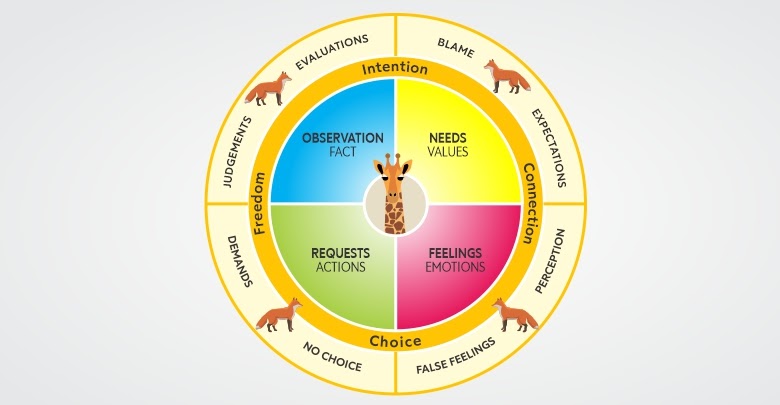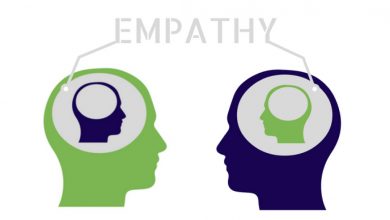Practicing compassionate communication
When we think of violence, we normally think of someone causing physical harm to another. Yet there is a much subtler form of violence, that can be equally damaging or more. The words we use have actual power to hurt or heal, and it is an unfortunate fact that violent communication is used frequently in everyday life, often with the perpetrator not even realizing what they are doing. The aim of this article is to not only describe non-violent (or compassionate) communication, but also to offer clear insight on how to practice it in everyday life and work.

Why did I choose this tool? Non-violent communication is one of the most effective methods that I have learned when it comes to communication. If everyone practiced non-violent communication, I believe that the quality of communication between people would be greatly improved and many problems would be prevented or solved. Talking about emotions isn’t something that most people are used to, and yet communicating about negative emotions is essential to being able to move past them instead of allowing them to build up and create negative repercussions for ourselves or others.
How does this apply to being a trainer?
Training is first and foremost a kind of communication with participants. Everything we do at the beginning of a training, like getting to know each other games, teambuilding exercises, is all with the purpose of creating a safe environment where learning and growing is possible. Violent communication, even the subtle version, has exactly the opposite effect. It causes participants to feel unsafe, and can cause hurt feelings in some cases breed aggression in some form. This is why understanding the difference between violent and non-violent communication is so important. First of all, so we can be conscious not to use violent communication as trainers (even in such a subtle form as “really you’re late again?”) and also, so we can intervene if we see that participants are using violent communication with each other. Aggression breeds aggression, and many times we don’t see the problem until it is too late. By understanding the cause of it, usually violent communication in some form, we can deal with it while it is still manageable and prevent anyone being harmed or detriment to the overall training environment and being able to reach your training goals. In addition to this, non-violent communication is an excellent method to share when you are delivering trainings on the topics of communication, childcare, conflict management, intercultural understanding and a host of other topics.
Main content:
Before we get into compassionate communication and how to practice it, it is worthwhile to define violent communication.
Violent communication is communication that limits liberty, denies recognition of needs, diminishes the worth of a person, and/or blocks compassion. Violent communication is often the result of using manipulative or coercive language that induces fear, guilt, shame, blame, duty, obligation, punishment, and/or reward. Violent communication happens in speaking and listening (and in thinking, through self-talks or imagined conversations). Common ways that violent communication occurs are through:
• Moralistic judgments and evaluations of others
Insulting, putting people down, labeling, criticizing, diagnosing, or seeing someone as “wrong”
• Denial of responsibility for our own feelings, thoughts, and actions
Blaming our feelings, thoughts, and actions on others, vague and impersonal forces, authority, policies, rules, regulations, social or gender roles, or uncontrollable impulses instead of our own choices and needs.
• Demands
Implied or explicit threat of blame, punishment or reward.
• Blocking compassion
Intellectual understanding that leads to trying to “fix” a situation by providing feedback that advises, shuts down, sympathizes with, educates, consoles, tells a story, corrects, explains, or interrogates a person.
Nonviolent Communication (abbreviated NVC, also called Compassionate Communication or Collaborative Communication) is an approach to nonviolent living developed by Marshall Rosenberg beginning in the 1960s.
At his heart there is a belief that all human beings have the capacity for compassion and empathy. We only resort to violence or harmful behavior towards others when we do not recognize more effective strategies for meeting our needs.
Habits of thinking and speaking which lead to use of violence (social, psychological and physical) are learned through culture. NVC theory supposes all human behavior stems from attempts to meet universal needs. The needs are never in conflict. Rather, conflict arises when strategies for meeting needs clash. NVC proposes people to identify shared needs, revealed by the thoughts and feelings surrounding these needs, and collaborate to develop strategies and make requests of each other to meet each other’s needs.
The result is interpersonal harmony and learning for future cooperation.
NVC supports change on three interconnected levels: within self, between others, and within groups and social systems. NVC greatest impact has been in personal development, relationships, and social change.
NVC is ostensibly taught as a process of interpersonal communication designed to improve compassionate connection to others. However, due to its far-reaching impact, it has many beneficial “side effects” as a spiritual practice, a set of values, parenting Best Practices, a tool for social change, a mediation tool, an educational orientation and as a worldview.
So how do you practice compassionate communication? I prefer the name compassionate communication because compassion and empathy go further then simply not being violent, and have a greater potential to positively impact the communication process.
Before learning any of the steps, it is essential to check your intention. You can be using all the right steps, but if your intention is not purely to communicate your feelings and to understand those of the other, you can still come across as aggressive and/or without empathy. Don’t try to practice non-violent communication if you are boiling over with anger. Rather do something to get calm and centered first, then use compassionate communication to work towards a sustainable solution to the problem you are facing. Compassionate communication can only work if your intention is to communicate from the heart and get results that help everyone and hurt no one.
Steps of compassionate communication (when you want to express your own feelings):
- Observation: ……………… is going on.
When it comes to the observation, it’s important to ensure that it is fully free of judgment and it is completely objective. For example, you might think that telling someone “you are being disrespectful” is objective, but they might not think that they were being disrespectful at all, and this communication will turn into an argument rather then a meaningful conversation. Instead, you can use the actual facts such as “you raised your voice at me and called me incompetent”, if this is what actually happened. Only use compassionate communication for what you have seen and experienced firsthand, to avoid adding interpretations of the facts and be able to stick to the actual observable events.
2. Feeling: I feel……………
Here you need to express your real emotions. Often, we run away from this step and try to use blame instead to make the other person wrong instead of just admitting that we feel sad, or disappointed, or stressed. It’s only by being vulnerable and expressing the real feeling that we can get to the core of the problem and consequently to the solution. By the same token, it’s important in this case to start the sentence with “I” instead of “you”, for instance “I feel sad” instead of “you made me feel sad”. “You made me feel sad” is still assigning blame to someone else for a negative emotion that you are experiencing, rather then simply expressing it.
3. Need: I need……………
Since at the basis of all negative emotions are unmet needs, here is your chance to express what need of yours isn’t being met that is causing you to have negative feelings. It could be
“I need to feel safe”, “I need more time”, “I need a hug”, “I need some time for myself” or any other unmet need that you feel is causing the problem.
4. Request: Can you…………….?
The request must be very specific, and it must be a question. It must be specific because your interpretation can be very different from someone else’s interpretation. If you say “can you be more respectful to me”, the other person can say yes but have a completely different interpretation of what that means, causing the same or a similar problem to happen again leaving you even more upset and disappointed. Instead you can say something like “is it possible to arrive on the times we agree on together”, or “can you call me aside and speak softly if you have something you want to tell me”, or any other action that would make the difference for you between “being respectful” and “being disrespectful”. The reason why it’s a question is because you need to give room for the other person to say yes, no, or to suggest another course of action. You need to be open to whatever the response may be, but chances are if you have taken the above steps carefully and compassionately, the other person will be eager to cooperate with you at this point.
5. Action: After the definitive response, taking the agreed upon action.
This is the opportunity to solidify whatever action you have both agreed on in the previous step. It should be concrete and clear to both sides, such as: “Ok I will call the project manger now and tell her we need more time.” or “Ok so the meeting is set for tomorrow at 8”. You can also take this chance to thank the other person for taking the time to understand the situation and for working together to reach a positive outcome. Communication at this level isn’t always easy, so when someone does spend the time and effort needed it’s important to acknowledge that, especially if you’re feeling much better now as a result of it.
Now let’s say the scenario is a bit different, you’re feeling fine but you see that someone else seems to be struggling or having negative feelings and you want to understand and support them. In this case you can actually use the exact same method, just in reverse so that you support the other person in expressing their feelings rather then expressing your own.
![]() Steps of compassionate communication in reverse (when you want to help someone else to express their feelings):
Steps of compassionate communication in reverse (when you want to help someone else to express their feelings):
6. Observation: What is going on?
Again, it should be as void of judgment and interpretation as much as possible. You may have to interpret a bit in order to have a starting point for talking to them, because when you notice someone is not feeling well you won’t automatically know all the facts behind it, but in this case it’s ok because you’ll give them the chance to tell you if it’s true or not and express how they really feel. Some examples are “you seemed a bit quiet at our meeting, and you’re normally so bubbly”, or “I didn’t see you at lunch, so I wondered if everything is ok.” or “I know things didn’t go exactly the way you planned during the training”.
7. Feeling: How does it make you feel?
Honestly ask “how are you feeling” or “how did it make you feel”? Don’t ask “are you ok” or “are you good” because this puts pressure on the person to say yes and close the discussion, rather then giving them the chance to open up and express how they really feel. Are you good/ok is more valid for a quick check when there isn’t much time available then for the full process of compassionate communication. Be open to whatever they might say, sometimes very small things can trigger very extreme negative emotions and it might not seem logical to you. Remember that your goal there is to understand the person and their feelings and not to evaluate whether they should be feeling that way or not. Never say “ah that’s so insignificant why would you worry about it” or something of that effect, because in doing so you are invalidating their feelings and defeating the purpose of compassionate communication.
8. Need: What do you need to make you feel better?
What do you need to make you feel better? Is it time off, or a meeting with the whole team about this issue, or better organization of the tasks, or a hug? Hopefully they will tell you outright what they need, but if they don’t, you can offer some suggestions, see how they respond, and then come to the real need where they say “yes this is exactly what it is”. Be patient and don’t take the first answer if it doesn’t sound like the real need. If you don’t meet the real need, the problem will continue even if it takes a different form. And from my experience, the stated problem is rarely the real underlying problem.
9. Request: So in light of all this, what can I do?
The request is different from the need in the sense that the need is their own, and the request is what you can do to fulfill it (or help it to be fulfilled). As mentioned above, it is ideal if they tell you directly, but if not patiently probe a bit until you see in their eyes that yes, this is what you can do to make things better.
10. Action: After the definitive response, taking the agreed upon action.
Take steps to follow through on whatever you agree on. This is really important otherwise you can come across as a big talker who doesn’t actually follow through on what they say, and this can create more damage in the trust level and communication and prevent them from opening up to you or trusting you again. Only agree on something you know that you can and will do, and then make sure to follow through.
Reflection questions:
What are the costs in terms of the relationship between myself and others if I use violent communication?
What is the potential cost to my well-being if I use violent communication?
Is controlling others by using violent communication effective?
On a level of 1 to 5 (5 being the highest and 1 the lowest), how good am I at honestly expressing myself, especially when I have negative emotions, in a compassionate way?
On a level of 1 to 5 (5 being the highest and 1 the lowest), how good am I at compassionately listening to and supporting someone when they are experiencing negative emotions?
When something negative happens, what is my first reaction? Is it to blame myself, or blame someone else?
Do I tend to shut down my negative feelings and go straight to the solution, or just ignore it altogether?
How might that negatively impact me and my relationship with other people?
What could be preventing me from expressing negative emotions (ex: being taught that negative emotions are bad and should be hidden, being afraid of being vulnerable, etc.)
What are the steps I am committed to taking to improve my compassionate communication skills?
Exercises:
How to apply it in everyday life:
- Every time something negative happens to you, instead of taking either extreme of repressing negative emotions or expressing them in a damaging way, practice using compassionate communication to express yourself until it becomes second nature to you.
- Whenever someone you care about (or work with regularly) is in a negative state, instead of avoiding them or getting upset at them practice using compassionate communication in reverse to understand how they really feel and support them in finding a solution.
- Practice observing the communication around you, at home, in public transportation, at work, between your colleagues, everywhere. Observe when you or someone else is using violent communication, and when compassionate communication is being used. In the situations where you have the power to do so, take steps to change the communication from violent to compassionate (with yourself, your children, your participants in a training, etc.)





